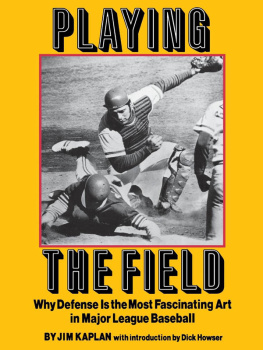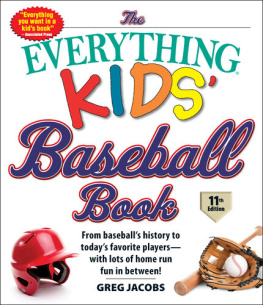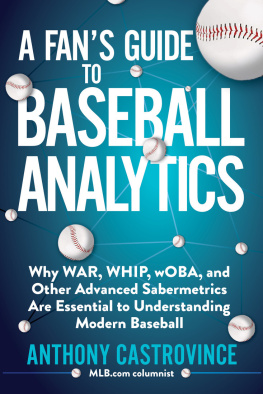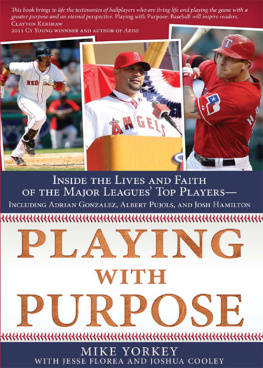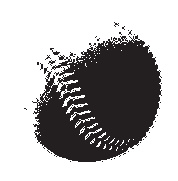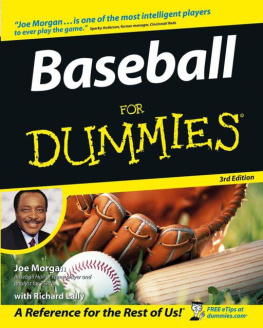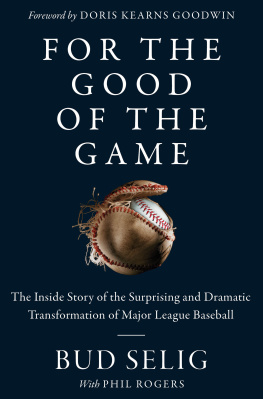
Jim Kaplan
Playing the Field
with an introduction by Dick Howser

Algonquin Books of Chapel Hill 1987
published by
Algonquin Books of Chapel Hill
Post Office Box 2225
Chapel Hill, North Carolina 27515-2225
a division of
Workman Publishing
225 Varick Street
New York, New York 10014
1987 by Jim Kaplan. All rights reserved.
Portions of this book appeared in Sports Illustrated, Sport, and The National Pastime.
Excerpts from Portnoys Complaint by Philip Roth in Chapter 12 reprinted by permission of Random House, Inc., copyright 1967 by Philip Roth.
We are indebted to the following organizations and persons for the photographs appearing in this book, which are used with their permission: Pat Kelly, National Baseball Library, Cooperstown, New York; Matthew L. Kaplan, New York, N.Y.; California Angels; Pittsburgh Pirates; San Diego Padres; Philadelphia Phillies; New York Yankees; Baltimore Orioles; Oakland Athletics; Boston Red Sox; Atlanta Braves; San Francisco Giants; Detroit Tigers; and UPI/Bettmann Archives.
LIBRARY OF CONGRESS CATALOGING-IN-PUBLICATION DATA IS AVAILABLE.
ISBN 978-1-61620-409-9
To my sons, Benjamin and Matthew
Contents
by Dick Howser
List of Illustrations
Introduction: The Necessity of Defense
by Dick Howser
There has never been a good baseball team that was not strong defensively. You used to be able to afford below-average leftfielders and rightfielders, but now you need good range at those positions because on artificial turf everyones running. I look for good range and a quick, accurate release more than I look for a strong arm. There are a lot of ways to compensate for a below-average arm, but not for a lack of speed. If you dont go get the ball, the opponents will run you out of the ballpark. Since the runners are so fast, its also more important than ever to know how to position your fielders and pitch to the hitters.
In 1985 we had to be especially strong in the field because we didnt score a lot of runs. If you dont score much, you cant afford to allow many runs. People say the up-the-middle positions are most important, and I believe it. The Royals have been contenders for the past decade or so in part because theyve been strong at catcher, short, second, and center. All the great Yankee and Oriole teams were like that. The catcher can maneuver people, infielders move around the shortstop and second baseman, and the outfielders work around the centerfielder. Just look at the guys we had in those positions when we won the Series. Our centerfielder, Willie Wilson, got as good a jump on fly balls as anyoneI still cant believe a ball he ran down off Ozzie Smith. Our catcher, Jim Sundberg, handled pitchers well and used his terrific arm. Frank White fielded perfectly. They talked about Buddy Biancalanas batting and on-base percentage. Well, dont forget his play at short. Over two seven-game series, he outplayed Tony Fernandez of the Blue Jays and Ozzie Smith of the Cardinals, two of the best in the business.
Every day in spring training we work on defensive fundamentals. Most of our guys are experienced, but we go over fundamentals as a reminder. Take the relays. We practice them on balls hit down the right-field line, over the rightfielders head, to right-center, over the centerfielders head. We practice them with nobody on base, a runner on first, runners on first and second. We use what we call a double cutoff, with both the shortstop and second baseman running into the outfield and one backing up the other. A good relay system helps prevent opponents from taking the extra bases that decide games.
Well also practice defensing the plays that teams use with men on first and third: the double steal, delayed steal, forced balk. What people dont understand about the double steal is that were not as concerned about getting the guy at second as we are preventing the guy at third from scoring. If the man on first steals second, first is open and we can pitch around the batter or walk the guy to set up a force. So when the man on first runs, we have several variations: throw through to a fielder at second who comes up throwing to third, throw to the middle infielder cutting behind the pitchers mound, throw to third for a pickoff. We also have to worry about what to do if the runner stops between first and second. Were constantly practicing rundowns. If were not doing them right, we might practice them on an off-day during the season.
We spend as much fielding practice with our pitchers as our everyday players. In addition to that familiar 3-1 play where the pitcher covers first on grounders, we practice holding runners, pitching out, working pickoffs. The pitcher has to learn to throw to first a lot and vary his timing to keep the runner off-stride. The throw to second is strictly a timing play between the pitcher and fielderthats why you go over it again and again and again. Its important for pitchers to hold runners and field their positionthe little things. They didnt have many runners in school and the minors. Even Dwight Gooden was below average at holding runners when he made the majors.
Its not always a big hit that wins a game, but its often a defensive play. And its not so much having good defensive players as guys who are in proper position. Before every series I go over hitters with the catcher, and one of our coaches, Billy Gardner, talks with the shortstop, second baseman, and centerfielder. During the game Billy is in charge of moving these players around. The players always move together. If, say, the centerfielder moves to left-center, the leftfielder moves toward the line and the rightfielder to right-center. If the shortstop moves in the hole, the second baseman moves closer to the bag.
Ive got hitting charts on opponents that go back to 1980. Whats on them? The ballpark, its dimensions, what pitch was hit, where it was in the strike zone, the count, whether it was a ground ball, a routine fly, a hard-hit fly. Say a righthanded hitter hits a ball to right-center. Was it a breaking ball away, a fastball on his hands, a pitch up or down in the strike zone; did he hit a looper into right field or hit it with authority? Maybe he hit a mistake pitch; in that case, we wont have to adjust the next time. If he keeps pounding the ball out there, hes a right-center hitter. Before he learned how to pull, we gave Kirby Puckett, the Twins righthanded hitting centerfielder, the left field line and had our shortstop almost behind second. Our charts showed that he hit to the right side and up the middle. Now that he swings differently, we need new charts. I like extensive charts. Once a guy has batted 40 or 50 times against us, we have something to work with. Another thing about charts: theyre a check on your memory. Heres what I mean. Every fielder remembers the hits that beat him. Last time through, this guy beat me on a hit up the middle, a shortstop will say, arguing in favor of moving to his left when the hitter comes up. But the charts will show that most of the time the guy pulls the ball. Percentages dont lie, and we play them. If a new guy comes into the league and theres no book on him, Ill talk to other managers or minor league managers who have worked against him.
We have a computer service that gives us what a guys hitting against various pitchers, how hes doing in day games and night games and in various ballparksthat kind of thing. But a computer cant replace what you see for yourself. If George Brett is hot, a printout of past performances wont help much. You have to have a feeling whether a players hot or cold, or if he has a fast bat or a slow bat. Computers also dont give you the most current information: whether a pitcher is going well or has a blister on his finger or is sick. If Dan Quisenberry is pitching for us, I usually have a feeling where the batter is going to hit the ball that a computer cant give me. Dans not going to pitch to their power, and the batter is probably going to hit the ball on the ground. All we can hope is that were playing the guy right, and he hits it to us. Baseball is not a computer game.
Next page
